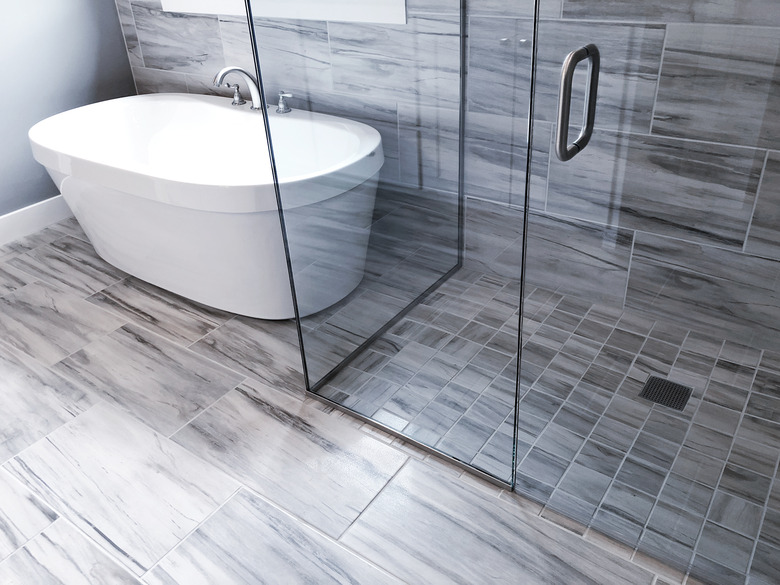How To Build A Curbless Walk In Shower
We may receive a commission on purchases made from links.
A curbless walk-in shower forms a seamless line with the bathroom floor. These shower stalls allow wheelchair access and facilitate easy entrance for those unable to enter a bathtub shower or curbed shower stall with ease. The level of difficulty involved in building a curbless walk-in shower ultimately depends on how much you need to modify your bathroom to accommodate a stall.
Curbless Walk-In Shower Base
Curbless Walk-In Shower Base
The shower base is comprised of three layers. These layers — the prepan, the pan and the shower floor — prevent water from leaking through the shower floor to the bathroom floor. To build a curbless walk-in shower, the shower pan and prepan must sit below the bathroom floor, so the shower floor sits even with the bathroom floor for a seamless walk-in. Shower pans create a watertight seal beneath the shower stall.
You can purchase premade shower pans, usually made of plastics such as PVC, or create one using a sheet of PVC or liquid membrane. Prepan materials vary considerably and include masonry and metal.
The Shower Walls
The Shower Walls
The materials you use for a curbless walk-in shower walls ultimately come down to personal preference. Bathroom walls built from tile require no modification. Painted surfaces, however, can suffer serious damage from moisture trapped in shower stalls.
Solutions include modifying walls by tiling over them and installing premade plastic walling designed for shower stalls. You can tile over surfaces such as wood, plaster, wallboards and masonry, though never over wallpapers or fabrics — you must remove paper or fabric before tiling. Installing premade plastic shower walling may require removing part of an existing wall.
The Right Flooring
The Right Flooring
Getting the right flooring for a curbless walk-in shower stall may entail extensive changes to your bathroom. If you want the shower to create a seamless floor line with your bathroom, you should tile the entire floor of the bathroom. Even if you install a door with a waterproof seal, water can leak from a curbless shower every time you open the door.
To avoid tiling the entire bathroom floor, you can install the shower floor below the level of the rest of the bathroom floor by removing a section of floor and setting the shower base deep into the floor. Or you can angle the floor so that water cannot escape through the door. Both approaches require significant modification of an area of floor.
Faucets and Doors
Faucets and Doors
Purchase doors and faucets for a curbless walk-in shower stall at a bathroom supply store, hardware store, department store or from an online retailer. Curbless shower stall doors hang slightly above the bathroom floor. You can also hire a contractor to build a customized door or surrounding wall from the ground up.
If your bathroom already contains a shower and you simply need to modify it to create a curbless walk-in, leave the shower head at its normal height and move the valve up the pipe so it sits 48 inches from the floor. Installing the valve too low can put the shower controls out of easy reach.
Wheelchair-Accessible Showers
Wheelchair-Accessible Showers
According to the 2010 ADA Standards for Accessible Design, an ADA-compliant standard roll-in shower must be at least 30 inches wide by 60 inches deep with at least a 60-inch opening at the front of the shower enclosure to accommodate a wheelchair. Install faucets and grab bars at heights that are comfortable for the wheelchair-bound individual for whom the shower is intended.
